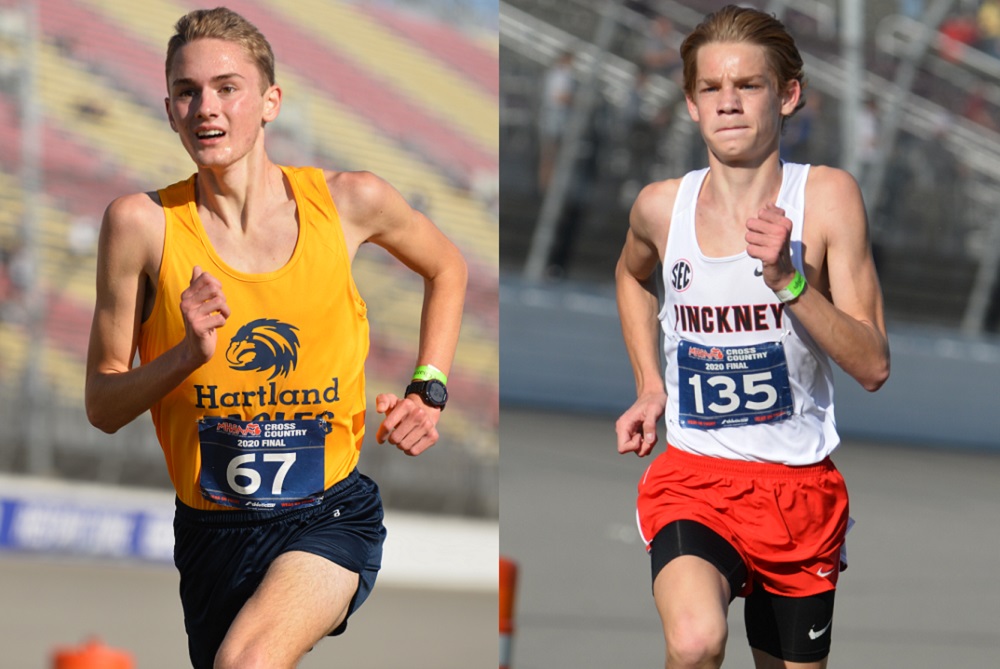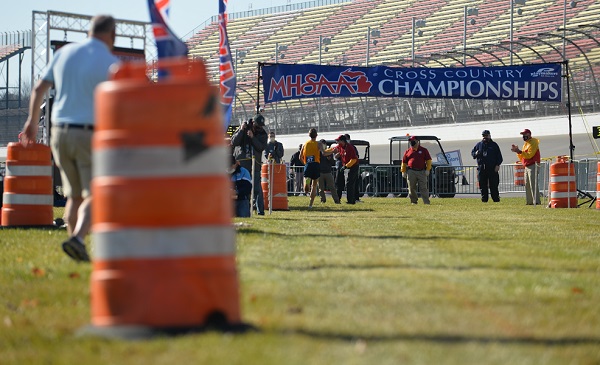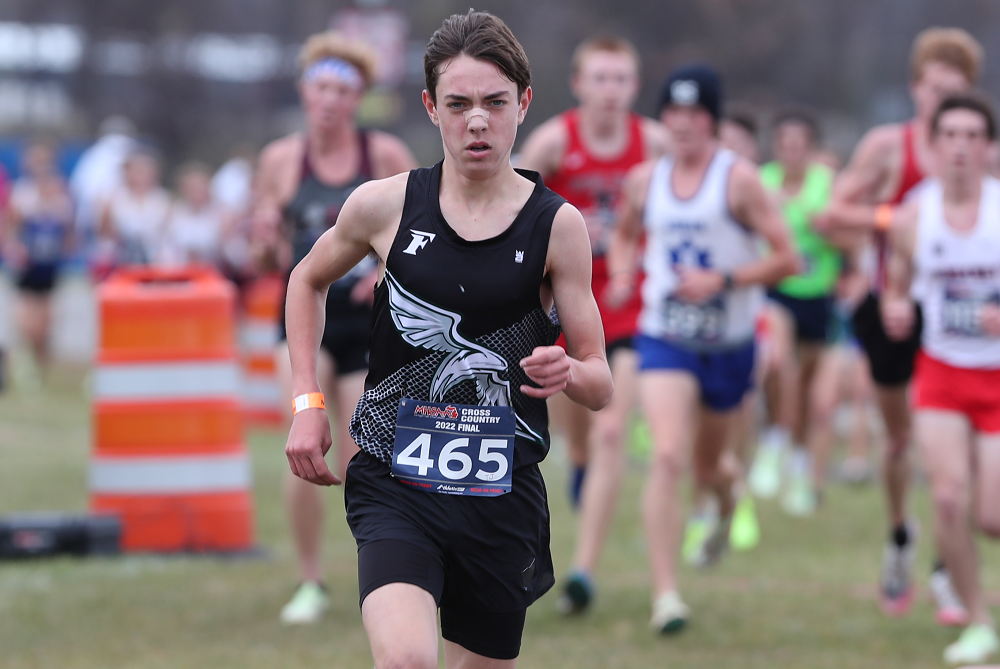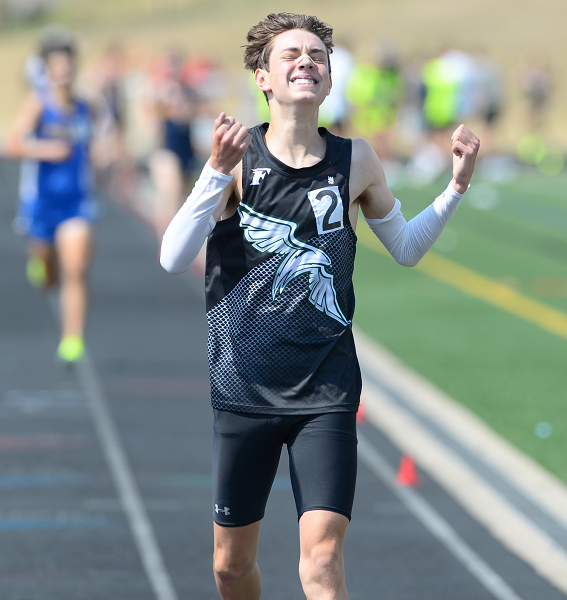
Livingston Pair Hough, Jarema, Primed for More Memorable Runs
By
Tim Robinson
Special for MHSAA.com
August 23, 2021
Hartland’s Riley Hough and Pinckney’s Caleb Jarema don’t see a lot of each other during their respective seasons, despite their schools being both located in Livingston County.
 Hartland is in Division 1 and Pinckney in Division 2, for starters, and they are in different conferences as well.
Hartland is in Division 1 and Pinckney in Division 2, for starters, and they are in different conferences as well.
They might have a rare chance to compete against each other in October’s Portage Invitational, provided Pinckney coach Jim Wicker can get his team into the Division 1 portion of the meet.
Otherwise Hough, who won the Lower Peninsula Division 1 Finals individual race last year, and Jarema, who was second last year in Division 2, may not face each other during this fall’s MHSAA season.
“We know each other pretty well,” Hough said. “We don’t talk too much, but when we’re racing we’re always talking a little bit.”
That is, until it’s time to go.
“Yes,” Hough said. “That’s when it gets silent and pretty serious.”
Both played soccer before turning to cross country. Hough got his start running while working on conditioning before playing soccer in the fourth and fifth grades.
“Then I did some local 5Ks, like the Howell Melon Run and the (Howell) Headless Horseman runs, and I saw I did pretty well for my age,” Hough said. “So did my parents. So we decided I could try cross country in the sixth grade, and it took off from there.”
Jarema took a different route. He played soccer and ran cross country his first two years of high school before giving up soccer before his junior year in 2020.
“I just started to enjoy running a lot more than soccer,” he explained, “and it became really hard to do both.”
It certainly worked out. Jarema improved from a 38th-place finish as a sophomore to second as a junior.
Both come from running families.
Jarema also was inspired by his older siblings. Brother Aaron is a senior at Ferris State University, while sister Courtney ran for a season at Oakland University.
“My brother was running for Pinckney, and I would be at his meets and it just seemed like a really fun environment,” Jarema said. “My brother was one of my role models, and I liked watching him run. I wanted to do the same thing he did, and then I ended up really enjoying it.”
Hough’s father, Jeff, competed at Corunna in high school, then went to Central Michigan University before finishing his career at William & Mary. He is an assistant coach at Hartland, and father and son talk running while driving to and from meets, among other things.
“He’s fortunate, or unfortunate, however you look at it, that he has to live with me,” Jeff says. “So we can discuss these things one-on-one. He’s very consistent at what he does, and it’s just a matter of improving from race to race. We’re down into small detail things now. He’s got the racing portion down now, We’re into the small, nitty-gritty things that can make a difference.”
 Both also know they are on everyone’s list this season. Hough's 14:49.62 last year was the second-fastest Finals time, all classes and divisions, since the championship race went to 5K in 1980. Jarema was one of only four runners to break 16 minutes in Division 2, and the other three runners graduated.
Both also know they are on everyone’s list this season. Hough's 14:49.62 last year was the second-fastest Finals time, all classes and divisions, since the championship race went to 5K in 1980. Jarema was one of only four runners to break 16 minutes in Division 2, and the other three runners graduated.
“There definitely is a mental pressure of having a target on your back,” Riley Hough said. “I’ve had it for a while and I know what it’s like. It’s hard. It helps push me along as well. It’s a little easier now that I’m used to it. Now that I’m a senior, I have these fast times and people are going to be gunning for me. It’s definitely going to be interesting.”
The times are the times, which give both confidence without veering into cockiness.
That also allows Jarema to admit, without any personal animosity, that he’s never beaten Hough.
“I feel I’m as good as anyone in the state,” Jarema said. “I mean, Riley is a phenomenal runner, and I may not be better than him. But I feel I can compete with him, for sure. So I feel there’s a target on my back, and yeah, I would say that it pushes me to be better off, for sure. I know there are kids who are working just as hard as me and are looking for the same type of breakout season.”
Both runners are part of teams that are close. Jarema talks about the importance of family, both his own and one created by his teammates. Hartland coach Matt Gutteridge, meanwhile, talks about Hough’s contributions on and off the race course.
“What I appreciate about Riley is how consistent he is,” Gutteridge said. “Whether it’s the training, or showing up and doing the little things, the leadership, I mean, he’s stepping up his game everywhere. He’s a consistent teammate and a consistent athlete. It’s fun to coach someone who’s that darn consistent.
“What he’s been able to do day in and day out still surprises me,” Gutteridge added. “He’s smart about his training. Even when he gets nicked up, he doesn’t shut it down. He pushes through it and is smart about it. That’s where I think he’s going to be successful, long-term. He really listens to his body, trusts his coaches, and the sky’s the limit for him.”
Pinckney coach Jim Wicker, a former Pirate who ran at Eastern Michigan, said he could see Jarema’s potential early.
“You could tell way back in the sixth grade he was going to be something special,” Wicker said. “He was always in the front, even if he was running against older kids. His talent and his competitive nature are just natural.
“He has high expectations and he really wants to be a Division I recruit,” Wicker continued. “He’s being recruited by some pretty good schools. I’m really proud of him. He’s doing a good job of staying grounded, keeping everything in perspective. He’s working hard, and I’m expecting big things from him.”
Hough and Jarema may have a few other chances to race each other this fall – potentially in non-MHSAA events after the Finals in November – and they’re both looking forward to possibly competing head-to-head.
“We definitely have conversations before the race, but once we get on the line it’s dead,” Jarema says of pre-race chit-chat. “He’s a super-nice kid, and I do really enjoy competing against him. You know, it’s more fun to compete against people who are friendly.”
PHOTOS: (Top) Hartland's Riley Hough, left, and Pinckney's Caleb Jarema sprint to the finish during last season's MHSAA Finals at Michigan International Speedway. (Middle) Hough crosses the line first in Division 1. (Click for more from RunMichigan.com.)

Freeland's Hansen Not Focused on Joining All-Time Greats - But On His Way
By
Paul Costanzo
Special for MHSAA.com
September 29, 2023
The goal written on Matt Kaczor’s Post-It Note was sub-15 minutes, 15 seconds. That’s what the Freeland cross country coach was hoping for from star runner TJ Hansen during his junior season.
 Kaczor tore it up after seeing Hansen run a single race this fall.
Kaczor tore it up after seeing Hansen run a single race this fall.
“Knowing what he did over the summer and where he was at, seeing what his 1,600 (meter) and his mile got down to, I had a feeling he could get under 15:30 quickly,” Kaczor said. “After the first race, I looked at my assistant and was like, ‘I’ve gotta rip up that Post-It Note. I don’t think our goal is on the level of where he’s at right now.’ At first, it was break 15:15. Once I saw him race at the Under the Lights (on Aug. 18 at St. Johns), I was like, ‘Yeah, he’s going sub 15.’”
Hansen ran 15:39.6 in that first race, and on Sept. 7, in Shepherd, he ran 15:13.9 to meet the goal written on the now-shredded Post-It Note.
This past Saturday, he ran 15:03.7 at the Cadillac Veterans Serving Veterans Invitational. It’s the fastest time recorded in Michigan this year, and a signal that Kaczor might be filling out a new Post-It Note before the season is out.
“The sub-15 barrier, that’s been something on my mind for a while,” Hansen said. “Now that I’m edging closer and closer to that, it’s been exciting. With how heavy my training has been, I wouldn’t expect (to have run this fast this early). Being able to run the times I am really paints the picture for what’s ahead.”
Hansen came into the season already regarded as one of the elite distance runners in the state. He won the 3,200 meters at the MHSAA Lower Peninsula Division 2 Track & Field Finals this past spring. He’s also finished all-state (12th and fifth, respectively) the past two seasons at the LPD2 Cross Country Finals.
His current trajectory, however, would put his name near some of the state’s all-time greats. But that’s not something Hansen is focusing on.
“I really don’t like to compare myself to others,” he said. “I don’t focus on that. I try to be the best TJ Hansen that I can be. The best version of myself.”
Focusing on himself is almost necessary for Hansen, as he’s spending a lot of time during his races running by himself.
At each of the big events Freeland has run in this season, Hansen has finished at least 20 seconds ahead of his nearest competitor. That includes all divisions of the Duane Raffin Festival of Races in Holly.
In Cadillac, where Hansen ran his current best time, he was a full minute ahead of the rest of the field.
 “He’s just a special athlete,” Kaczor said. “I can’t see Freeland having someone like this in a while. He’s a generational talent. What’s crazy is, I had the school record when he was a freshman. He and Braden (Honsinger) broke it last year. But TJ has now dropped that school record (set in 1998) by almost a minute.”
“He’s just a special athlete,” Kaczor said. “I can’t see Freeland having someone like this in a while. He’s a generational talent. What’s crazy is, I had the school record when he was a freshman. He and Braden (Honsinger) broke it last year. But TJ has now dropped that school record (set in 1998) by almost a minute.”
Hansen’s achievements have already put him on a path to run at the next level, which is something of a family tradition.
His older sisters Peyton and Kiera are track & field athletes at Wayne State and Eastern Michigan, respectively. Their parents, Tim and Pam, were track & field stars at Central Michigan.
TJ has drawn the attention of coaches around the country, including from Michigan, Michigan State, Wisconsin, Tennessee and Colorado.
Having family members who know the process is a help for Hansen, and he said they’ve all been good about allowing him to choose his own path, whatever that may be.
“He’s from a good family that knows how to work and knows how to get things done,” Kaczor said. “He knows that if he puts in the work, he’s going to be at a good spot.”
While Hansen admits it can be a bit overwhelming, he’s using it as motivation to run faster and continue to put his name out there.
Also serving as motivation is 2022 Division 2 champion Connell Alford of Chelsea. Alford is among the elite group of runners in Michigan who have broken the 15-minute mark, doing it twice a year ago.
He currently has the state’s second-best time behind Hansen’s this year, running 15:09.1 at the MSU Invitational on Sept. 15.
“Whenever I see him drop a time, my main goal is to run faster,” Hansen said. “Whenever I see him run a good time, that motivates me to work hard.”
The two won’t see each other until the MHSAA Finals on Nov. 4 at Michigan International Speedway. It’s an opportunity Hansen is excited for, as it’s a chance to race and be pushed toward the lofty goals he’s set for himself. Kaczor is excited about it, too, even if it might mean having to replenish his supply of Post-Its.
“We don’t talk about winning the state title; we talk about making sure that we have great races on those days,” Kaczor said. “We can’t control how somebody else runs. It’s a matter of can we, if the weather is right and the course is in good condition, can we be one of the few guys that has run in the 14s on that course? That’s the goal. Put yourself in some great categories with those upper echelons and the greats of all-time.”
 Paul Costanzo served as a sportswriter at The Port Huron Times Herald from 2006-15, including three years as lead sportswriter, and prior to that as sports editor at the Hillsdale Daily News from 2005-06. He can be reached at [email protected] with story ideas for Genesee, Lapeer, St. Clair, Sanilac, Huron, Tuscola, Saginaw, Bay, Arenac, Midland and Gladwin counties.
Paul Costanzo served as a sportswriter at The Port Huron Times Herald from 2006-15, including three years as lead sportswriter, and prior to that as sports editor at the Hillsdale Daily News from 2005-06. He can be reached at [email protected] with story ideas for Genesee, Lapeer, St. Clair, Sanilac, Huron, Tuscola, Saginaw, Bay, Arenac, Midland and Gladwin counties.
PHOTOS (Top) Freeland's TJ Hansen leads a pack during last season's LPD2 Final at Michigan International Speedway. (Middle) Hansen enjoys a moment of exhilaration after winning the 3,200 this spring at the LPD2 Finals at Ada Forest Hills Eastern. (Top photo by Carter Sherline/Run Michigan; middle photo by Dave McCauley/Run Michigan.)

